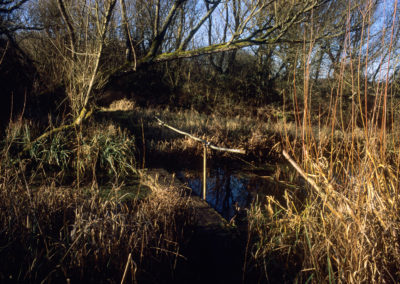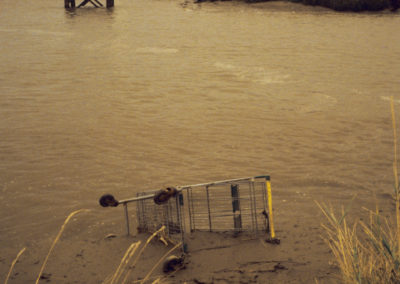Along an old River (the Nar, Norfolk)
This is my favourite place.

My first encounters with the river Nar took place long before I ever thought about photographing it, and before I was even aware of the river by name. During my childhood my family would often make the journey to the nearby port town of King’s Lynn, where my maternal grandparents lived. I remember one year going to watch the 5th November Guy Fawkes Night fire work display in the town. I stood amongst the crowd with my mum, dad and brother on the quay side of the river Great Ouse as the cold air filled with flashes of light and the smell of gunpowder. At the time I was not aware that just a few meters away, the muddy waters I had sometimes looked at clutching my mother’s hand was the mouth of the old river Nar flowing into the Ouse. Just a dozen or so miles along the coast is my home village of Heacham. I guess if I had thought about it – like the great explorers of old – I could have set sail from Heacham’s sand and shingle beach, past the site of King John’s lost sunken jewels in the Wash, and followed the tidal coast to King’s Lynn, where I would drift for a mile or so along the Ouse and suddenly veer off left into the mouth of the Nar, and sail inland in search of a great civilisation. Indeed, the Nar was once worthy of such a journey when the Romans and later the Normans inhabited the settlement of Castle Acre, an historic village located along the river.
I never encountered the Nar by boat, but I did by bike. Just two miles inland from Heacham is the old Roman road of Peddars Way – a straight rolling dirt track that goes 16 miles to Castle Acre and then beyond to Thetford. The Peddars Way is perfect territory for a mountain bike. Often I would make this journey to Castle Acre. When I reached the village I would ride down South Acre Road, a small lane past the church, down to where it fords the river. Here I would take a rest on the river bank and eat an apple, maybe also eat a bar of chocolate, and drink some water while I watched the Nar flow by. The ruins of the ancient Priory would stand in the distance like a film set or a mirage. Each time I would see it and think to myself, “this little river must be very old.”
In the years that followed, many things happened and I spent some-time living away from Norfolk, but I never forgot the old river Nar. Finally, twenty years later I began returning to the landscape of the Nar, but this time I had a camera. Gradually over a period of eight years (2010-2017) I photographed the Nar and its landscape, 26 miles from the source – which like the source of most rivers was pretty much non-existent – to the river mouth in King’s Lynn. These photographs show what I saw. As always, there was no great agenda for what I would photograph, I just wandered and explored and discovered this little part of Norfolk. It is almost a cliché now to photograph a river. But unlike the Mississippi, the Yangtze, or even the Thames, the Nar is very insignificant and that is what interested me: I wondered, “can I even take interesting photographs along a minor river like this?” But the Nar does have some significance in that it is a designated Site of Special Scientific Interest (SSSI) and is one of just 200 or so chalk streams in the world, the majority of them being in southern England.
The Nar flows through a mix of fields, water meadows, marshy flood plains and woodland, much of it private. I mainly photographed the river’s landscape in the Autumn and Winter when the habitat had died off and allowed me to access these places. One Summer I tried to photograph a particular stretch of the river, and after fighting my way through dense head-height wild plants and flowers while dragonflies buzzed around, I realised it would be impossible to work in the dense growth and I could not even see the river, so I gave up.

In a number of locations the river Nar and its surroundings are exceptionally beautiful, and I think the word “bucolic” exists particularly to describe some of the places that I came to know along this little river. This is why it is my favourite place. But as I journeyed down the Nar I discovered that even the best of places are not immune from the damage and neglect inflicted by the human hand and the often senseless mind that guides it. When the Nar reaches the environs of King’s Lynn it visibly becomes part of a damaged and defaced landscape. Here the river is far from bucolic. Instead it was earie and unsettling, at times even threatening. Even this simple little river has become a reflection of the failed system in which we live: it has been poisoned (perhaps literally) by many years of careless, aggressive decision making based on capitalist agendas; a process that ultimately infiltrates the lives of most of us and the environments we inhabit.
The afternoon when I was taking my final photographs along the Nar was especially poignant. It was Monday 16th October 2017, and as I walked and photographed I observed the sky change colour to a tone of sepia – a phenomenon that was caused by a combination of smoke from forest fires in Spain and Portugal mixing with sand blown in from the Sahara by Hurricane Ophelia. Eventually I made my way to the river’s end. Surrounded by the strange orange glow I stood looking into the muddy waters of the river mouth, and I was filled with great sadness.
A selection of the images from the series are shown below (click to view image at full size / original format).
ABOUT JUSTIN PARTYKA
Justin Partyka is from the county of Norfolk on the east coast of the UK, and now lives in the historic hill-top city of Poitiers in mid-west France. Justin has been making photographs for over twenty years. After completing a Masters degree in folklore and ethnography at Memorial University in Newfoundland, Canada, Justin returned to his native region of East Anglia and dedicated himself to photographing the rural landscape and culture over a period of many years. His work often focuses on a local sense of place and considers how elements of the past continue to exist in the present.
Justin’s photographs have been exhibited widely including at Tate Britain, London; the Sainsbury Centre for Visual Arts, Norwich; the Museum of English Rural Life, Reading; and the Boutographies photo festival in Montpellier, France. Publications include Granta magazine, the Guardian weekend magazine, Source magazine, the limited-edition books Field Work and Not Exactly Nature Writing, and a commissioned series of photographs for a reissue of the classic book of oral history Fenwomen.
Justin’s extensive photography in his native region of East Anglia consists of multiple bodies of work and he is currently working on bringing these together for a major exhibition and publishing project, Close to Home. Justin’s other projects include photographs made in Saskatchewan, Canada, and Cádiz, Spain. He has also photographed in other parts of the United Kingdom, Paris, Berlin, Toronto, Sicily, and various locations in the United States. Since 2015 he has been developing a new body of work in the Nouvelle-Aquitaine region of France.
Justin sometimes teaches photo workshops and offers mentoring to committed photographers who want to try and take better photographs. He is the first to admit that photography is almost an impossible endeavour, and that is what makes it worthwhile. Along with photography, Justin’s other passion is music and he is an avid collector. He would happily spend an afternoon discussing the intricate details of a Bob Dylan live bootleg recording, the evolution of a Grateful Dead show, the importance of The Carter Family, the perfection of 1950s and 60s Blue Note albums, or the genius of David Berman; rather than discussions about Leica cameras, the best film, the perfect lens focal length, Eugene Atget and Lee Friedlander. Although he has opinions on the latter too!
Website: justinpartyka.com
Etsy: shop/ateliergalerie161
Instagram: @161poitiers
CREDITS
Unless otherwise stated, all words and images in this article are © Justin Partyka
























